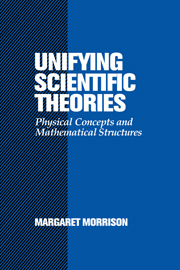Book contents
- Frontmatter
- Contents
- Acknowledgements
- Introduction
- 1 The Many Faces of Unity
- 2 Unification, Realism and Inference
- 3 Maxwell's Unification of Electromagnetism and Optics
- 4 Gauges, Symmetries and Forces: The Electroweak Unification
- 5 Special Relativity and the Unity of Physics
- 6 Darwin and Natural Selection: Unification versus Explanation
- 7 Structural Unity and the Biological Synthesis
- Conclusions
- Notes
- References
- Index
1 - The Many Faces of Unity
Published online by Cambridge University Press: 06 October 2009
- Frontmatter
- Contents
- Acknowledgements
- Introduction
- 1 The Many Faces of Unity
- 2 Unification, Realism and Inference
- 3 Maxwell's Unification of Electromagnetism and Optics
- 4 Gauges, Symmetries and Forces: The Electroweak Unification
- 5 Special Relativity and the Unity of Physics
- 6 Darwin and Natural Selection: Unification versus Explanation
- 7 Structural Unity and the Biological Synthesis
- Conclusions
- Notes
- References
- Index
Summary
Kepler: Unity as Mathematical Metaphysics
In the Mysterium cosmographicum Johannes Kepler claimed that it was his intention to show that the celestial “machine” was not a kind of divine living being,
but a kind of clockwork insofar as the multiplicity of motions depends on a single, quite simple magnetic and corporeal force, just as all the motions of a clock depend upon a simple weight. And I also show that this physical cause can be determined numerically and geometrically. (Kepler 1938, xv:232)
His research began with a specification of certain astronomical hypotheses based on observation; that was followed by a specification of geometrical hypotheses from which the astronomical ones would follow or could be calculated. Those geometrical hypotheses were grounded in the idea that God created the solar system according to a mathematical pattern. Given that assumption, Kepler attempted to correlate the distances of the planets from the sun with the radii of spherical shells that were inscribed within and circumscribed around a nest of solids. The goal was to find agreement between the observed ratios of the radii of the planets and the ratios calculated from the geometry of the nested solids. Although unsuccessful, Kepler remained convinced that there were underlying mathematical harmonies that could explain the discrepancies between his geometrical theory and ratios calculated from observations.
Part of Kepler's unfaltering reliance on mathematical harmonies or hypotheses was based on their direct relationship to physical bodies. He considered a mathematical hypothesis to be physically true when it corresponded directly to physically real bodies. What “corresponding directly” meant was that it described their motions in the simplest way possible.
Information
- Type
- Chapter
- Information
- Unifying Scientific TheoriesPhysical Concepts and Mathematical Structures, pp. 7 - 34Publisher: Cambridge University PressPrint publication year: 2000
